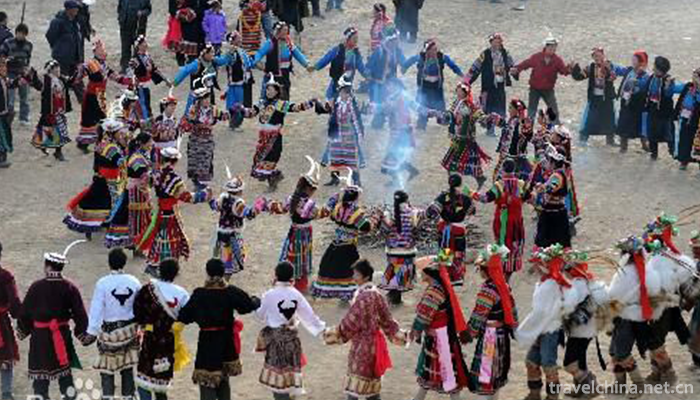Panda Dance
Panda dance is a traditional dance originating in Jiuzhaigou County. Every year on the 15th and 16th of the first lunar month, some of the Baima Tibetans wear panda masks to exorcise evil spirits. This unique sacrificial dance has been passed down from generation to generation in the way of family inheritance. At the age of seven or eight, Mao Yunan studied Panda Dance with Uncle Yang Jinbao, according to the wind. As a rule, he was not allowed to wear panda masks until he reached the age of 15 to participate in official sacrificial performances in the village.
On November 11, 2014, panda dance was approved by the State Council and listed in the fourth batch of national intangible cultural heritage list.
brief introduction
Baima Tibetans have always retained the custom of dancing "Zeus idols". Baima Tibetans dance masks, Cao Cao Cao and Cao Mu, which are called "Zeus idols", are typical Nuo dances. The dance originates from the ancient Benbo "Baibeast Dance". On the first day of Baima Tibetans'dancing, that is, on the sixth day of the first lunar month, they want to dance a kind of "Chao Cover" dance with a mask on their head, that is, the old bear dance. According to legend, Baima Tibetans are "snatchers". (Black Bear) and "Duoga" (White Bear) are descendants of the combination. Devils and monsters fear the bear god, so dancers can disguise the bear God and subdue all the ghosts. During the performance, a performer wears a black bear head (boneless specimen), carries wooden sticks and wooden knives and spears, and leaps forward with the sound of gongs and drums. In modern times, with the emergence of the word "Duoga Dance" (White Panda Dance) has become a panda. Dance.
Panda dance has been appraised by the second batch of provincial intangible cultural heritage list appraisal committee in Sichuan province, and considered by the joint meeting of Sichuan intangible cultural heritage protection workshops, it has been listed as the second batch of Sichuan intangible cultural heritage list.
Baima Tibetan people live in Tangzhu River and upper and middle reaches of Baishui River in the southwest of Jiuzhaigou County, with a total population of more than 4600. Baima people are good at singing and dancing, hospitable and have a legendary and unique culture.
Historical sources
Baima Tibetan has a long history. During the Eastern Expedition of Tubo in the Sui and Tang Dynasties (618 A.D.), it was a place for military strategists to compete for. Later, Tibetan soldiers stayed behind and intermarried with local people (Di people), gradually forming a unique integration culture of Baima people, that is, the integration of Diqiang culture and Tibetan culture.
In the early days of Songzan Ganbu, Ben religion prevailed. An investigation report on Ben religion in Western Sichuan stated: "During Songzan Ganbu's Eastern Expedition, there were benzoic wizards accompanying the troops, and there were large benzoic wizards in every thousand families, called La Bo, and a small wizard in every battle group, called La Ba." Benzoic Masters wore animal masks when leading soldiers to sacrifice. In the period of democratic reform, these masks remained. There are only twelve left now. So what people call "twelve-phase dance" is actually twelve masks, such as lion, tiger, leopard, dragon, ox, chisel, phoenix, sacrifice, ghost, ghost, ugly Mo (earth mother) and so on, instead of the twelve zodiac signs. After the general panda dance is over, the "hundred beasts dance" is performed on the seventh day of the first month of the first month. When performing the hundred beasts dance, a banner of Mountain God is erected with a naked body and a shoulder-cape tiger painted on it. Skin, right-handed stone axe, left-handed holding nude baby tribal protection god image, dozens of masked actors follow a wizard, and jump counter-clockwise in reverse circles. Body movements are mainly reflected in the changes of hands and feet. Dance for two sections, each section is divided into 10-15 segments, each section has some sets before. The second section shows the animals participating in the sacrifice before the sacrifice. Fear. Four of the dances imitate animal movements, such as Phoenix dance, monkey dance, ghost dance (imitating goat movements), etc. Zeus idol dance has no songs and no songs, mainly accompanied by percussion music, mainly with drums and cymbals.
Development
From Nov. 28 to Nov. 30, 2011, two journalists from seven CCTV programs "Local Land" entered Jiuzhaigou County, Aba Prefecture, taking the national intangible cultural heritage "Crepe Dance", provincial intangible cultural heritage "Panda Dance" and traditional splendid "Tumo Festival", unique dietary culture, exotic and colorful Baima Tibetan folk customs and other genres as the shooting content. Shooting and producing public welfare tourism and culture programs to show the unique and colorful folk culture of Jiuzhaigou County to the outside world.

0 Questions
Ask a Question
Your email address will not be published.